According to national resolutions and legislation, child labour is defined as children aged 5-13 years working for at least 1 hour during a working week; children aged 14-17 years working for at least 36 hours during the reference week; children involved in hazardous work, (as defined in the list of hazardous work provided); and/or children working at night. The report on Child labour in Nepal finds that approximately 286,000 children are involved in work for pay. An estimated 17% of children are involved in forced labour. The reason identified for child labour includes push and pull factors such as poverty, low education status and family violence. However, we do not know the number of children in hazardous work.
Social security for children in Nepal
In Nepal, the Child Labour (Prohibition and Regulation) Act, 2000; Constitution of Nepal (2015); the Labour Act, 2017; the Muluki Civil Code, 2017 and the Children’s Act, 2018 all reference the protection of children and child labour. The Government of Nepal have social protection programmes to tackle child poverty and vulnerability, such as free education until high school, cash transfer programmes, child grant and disability allowance. Even though the social security of children is the governments’ responsibility, we cannot deny the importance of community engagement to protect children from child labour and help create an enabling environment for children. Civil Society Organisations have been contributing significantly to increase the child sensitiveness of the social security measures. The importance of addressing the underlying social, economic and political vulnerabilities that force children into child labour and the worst form of child labour (WFCL) has been highlighted by a number of research articles and reports. It is important to increase the access of children and social activists working for children to social protection mechanisms, enhanced health care and income security. In addition to this, education; the promotion and implementation of child safeguarding, child sensitive work ethics and practice; advocation for federal, provincial and local level social protection strategies and guidelines for marginalized, vulnerable and at risk population are important. It is therefore vital for the Government of Nepal to foster a multi-sectorial effort to invest, scale up and support strengthening of social security and protection systems for children in Nepal.
CLARISSA Nepal has been contributing to evidence generation on various components of child labour through multiple lenses. CLARISSA Nepal has so far collected the life stories of 400 child labourers. The stories identify the socio-economic and political hardships of children which led them to child labour. Through our Action Research Groups, socio-economic issues such as stopping education, re-entering WFCL, poverty, family conflict, homelessness and family neglect are being considered further in four areas of Kathmandu valley. CLARISSA Nepal has also formed a Children’s Research Group which is a platform for child labourers to generate evidence that matters most to them.
Through GIS-mapping, CLARISSA Nepal wants to understand causal linkages between places and child labour in its worst forms, and to shift neighbourhood dynamics to prevent children from WFCL or to make child labour less harmful for children. Thus, CLARISSA Nepal has been implementing child focused and child-led research in Nepal to understand the push and pull factors, business dynamics and the impact of COVID-19 on child labourers and businesses.
Need for a paradigm shift
One of the important things we’ve learnt through the evidence generated from CLARISSA is how social security and protection can help eliminate child labour. The researcher conducted previously on child labour were more focused on the number of children working in child labour, identifying, rescuing and reintegrating them. However, evidence from CLARISSA shows the frequent re-entry of children into child labour due to their socio-economic situation. The need for an interventional paradigm shift from rescue and reintegration to evidence-based actions is key.
In the context of Nepal, CLARISSA has been an innovative project to sensitise and challenge assumptions about child labour in Nepal through children-led research, action research, and ethnographic research. Participatory, child-led and ethnographic processes helps to focus on knowledge, information and realities which can address complex issues such pathways to WFCL; push and pull factors of WFCL; demand and supply chains; risk, resilience and adaptation and exploring the relationship between formal and informal sectors. For this, it is important to generate demand and invest in research based project and programmes, to map the policy landscape related to child labour and existing social protection mechanisms and to build agency for children for positive outcomes.
